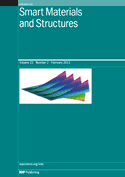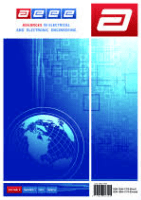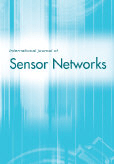
Smart Structures and Systems
Scope & Guideline
Pioneering Research in Smart Engineering
Introduction
Aims and Scopes
- Smart Materials and Structures:
Research on materials that can respond to environmental changes, including shape memory alloys and piezoelectric materials, to create structures that adapt dynamically to stresses. - Structural Health Monitoring (SHM):
Innovative approaches to monitor and assess the condition of structures using sensors, data analytics, and machine learning techniques to predict failures and optimize maintenance. - Control Systems for Civil Engineering:
Development of advanced control strategies, including adaptive and intelligent control systems, for managing the dynamic response of structures under various loading conditions such as earthquakes and winds. - Data-Driven Modeling and Machine Learning:
Application of machine learning and data-driven techniques to analyze structural behavior, detect anomalies, and improve predictive maintenance strategies. - Sustainable and Resilient Infrastructure:
Focus on the design and analysis of structures to enhance resilience against natural disasters and promote sustainable practices in construction and material usage. - Integration of IoT in Structural Engineering:
Research on the incorporation of Internet of Things (IoT) technologies to facilitate real-time monitoring and control of structural systems, enhancing operational efficiency. - Simulation and Experimental Validation:
Studies that combine numerical simulations with experimental validation to assess the performance of new structural designs and materials.
Trending and Emerging
- Artificial Intelligence and Machine Learning:
There is a significant increase in the use of AI and machine learning techniques for predictive modeling, damage detection, and optimization of structural systems, highlighting a trend towards smart and automated solutions. - Digital Twin Technology:
The concept of digital twins is gaining traction, with research focusing on creating virtual replicas of structures for real-time monitoring and simulation, enhancing decision-making processes in infrastructure management. - Resilience Engineering:
Emerging studies emphasize the resilience of infrastructure against extreme events, with a growing body of research dedicated to developing strategies that enhance the durability and safety of structures under various stressors. - Sustainable Design Practices:
There is a rising trend towards incorporating sustainability into structural design, with a focus on eco-friendly materials and energy-efficient construction practices that align with global sustainability goals. - Advanced Sensing Technologies:
The integration of advanced sensing technologies, such as fiber optics and wireless sensor networks, is on the rise, enabling more comprehensive and effective monitoring of structural health. - Remote Sensing and UAV Applications:
Research utilizing drones and remote sensing technologies for structural inspections and assessments is increasingly prevalent, reflecting a shift towards more efficient and safer inspection methods.
Declining or Waning
- Traditional Structural Analysis Techniques:
There has been a noticeable decrease in the publication of papers relying solely on conventional structural analysis methods, as the field increasingly embraces advanced computational techniques and data-driven approaches. - Static Load Testing:
Research centered on static load testing of structures has waned, likely due to the growing preference for more dynamic and real-time monitoring solutions that provide continuous data on structural performance. - Non-Smart Materials:
Papers discussing non-smart materials are appearing less frequently, as the focus shifts towards smart materials that offer enhanced capabilities and functionalities in structural applications. - Basic Sensor Technologies:
There is a declining interest in basic sensor technologies, with a shift towards more sophisticated and integrated sensor networks that leverage IoT and advanced data analytics. - Single-Disciplinary Approaches:
Research published using single-disciplinary approaches is becoming less common, as interdisciplinary collaboration is increasingly recognized as essential for addressing complex structural challenges.
Similar Journals

Machines
Connecting researchers to foster collaboration and innovation.Machines is a leading journal in the fields of engineering and computer science, published by MDPI in Switzerland since 2013. As an Open Access publication, it ensures that researchers, professionals, and students can freely access high-quality peer-reviewed research. The journal covers a diverse range of topics, including control and optimization, mechanical engineering, electrical engineering, and industrial manufacturing, boasting impressive rankings in various Scopus categories, such as Q2 in Computer Science and Control Systems Engineering. With a commitment to advancing knowledge and innovation in these critical areas, Machines serves as an essential platform for disseminating research findings and fostering collaboration within the academic community. By contributing to the ongoing dialogue in these dynamic fields, the journal plays a pivotal role in shaping the future of technology and engineering practices.

Smart Materials and Structures
Pioneering Research in Smart Materials and StructuresSmart Materials and Structures, published by IOP Publishing Ltd, is a leading journal in the realms of engineering and physics, with an impressive reputation for disseminating transformative research relevant to Atomic and Molecular Physics, Civil and Structural Engineering, Condensed Matter Physics, Electrical and Electronic Engineering, and Materials Science. Since its inception in 1992, this journal has become a cornerstone in the study of innovative materials and their potential applications in various domains. With a remarkable impact reflected in its Q1 rankings across multiple categories for 2023 and its notable Scopus standings, Smart Materials and Structures serves as an essential platform for scholars and practitioners aiming to stay at the forefront of material science advancements. Although the journal operates under traditional access, it ensures that critical findings and methodologies in smart materials are readily available to a global audience, fostering collaboration and innovation in technology and engineering. Respected for its rigorous peer-review process, the journal encourages submissions that present original research, review articles, and significant case studies that can lead to groundbreaking developments in smart material applications.

International Journal of Integrated Engineering
Empowering researchers to shape the future of integrated engineering.International Journal of Integrated Engineering, published by UNIV TUN HUSSEIN ONN MALAYSIA, serves as a critical platform for disseminating research and advancements in the comprehensive field of integrated engineering. With an ISSN of 2229-838X, this journal is pivotal in enhancing interdisciplinary collaboration and innovation across numerous engineering domains, including Civil, Electrical, Mechanical, and Industrial Engineering. Although it currently holds various Q4 categories and competitors in the Scopus ranks, the journal consistently aims towards enhancing its impact and expanding its scope. Researchers can benefit from sharing their findings with a growing audience keen on the latest engineering developments. The journal emphasizes open access, making it a vital resource for academics, practitioners, and students alike who seek to stay informed about emerging trends and technologies in integrated engineering.

Journal of Civil Structural Health Monitoring
Empowering engineers with cutting-edge insights into structural health.The Journal of Civil Structural Health Monitoring, published by SPRINGER HEIDELBERG, is a premier academic journal dedicated to advancing the field of civil and structural engineering, with a specific focus on the health monitoring of infrastructure systems. With an ISSN of 2190-5452 and an E-ISSN of 2190-5479, the journal has established itself as a leading source of rigorous research, evidenced by its impressive Q1 rankings in both Civil and Structural Engineering and Safety, Risk, Reliability, and Quality categories for 2023. As a widely respected platform, the journal offers researchers and practitioners access to high-impact studies, innovative technologies, and insights into the ongoing efforts to enhance infrastructure resilience. Despite its lack of an open-access model, the journal's content is accessible through institutional libraries, ensuring that a wide audience of engineers and scientists can benefit from the latest advancements. With its converged years from 2011 to 2024, the journal continues to play a vital role in shaping best practices and policy decisions in civil engineering, making it an invaluable resource for professionals, scholars, and students alike.

Studies in Informatics and Control
Exploring Cutting-Edge Research in TechnologyStudies in Informatics and Control is a distinguished academic journal published by the NATL INST R&D INFORMATICS-ICI, specializing in the interdisciplinary fields of Computer Science and Electrical and Electronic Engineering. With an ISSN of 1220-1766 and a recognized standing within its field, this journal aims to foster innovation and disseminate high-quality research findings from 2010 through 2024. It maintains a significant presence in the academic landscape, holding a Q3 ranking in both Computer Science (miscellaneous) and Electrical and Electronic Engineering categories for 2023, which underscores its commitment to advancing knowledge and technology in these areas. While the journal is not open access, it provides valuable insights and results that are essential for researchers, professionals, and students striving to develop their expertise in informatics and control systems. Based in Romania, its contributions traverse international boundaries, appealing to a global audience keen on the latest developments and trends within these rapidly evolving fields.

Journal of Ambient Intelligence and Smart Environments
Advancing Smart Solutions for Everyday Living.Journal of Ambient Intelligence and Smart Environments is a premier publication dedicated to advancing the interdisciplinary field of ambient intelligence and smart environments. Published by IOS PRESS in the Netherlands, this journal focuses on innovative applications of technology in everyday environments, promoting research that intersects computer science and human-centric design. With an ISSN of 1876-1364 and an E-ISSN of 1876-1372, it serves as a critical platform for disseminating high-quality research findings from 2009 to 2024. Despite holding a Scopus rank of #199 out of 407 in the Computer Science - Software category, placing it in the 51st percentile, the journal has consistently contributed valuable insights into the development of intelligent systems that enhance user experiences. Although currently not an open access journal, it remains an essential resource for researchers, professionals, and students aiming to explore the latest trends and outcomes in smart technology and environments, further fostering collaboration across disciplines and enhancing academic dialogue.

Advances in Electrical and Electronic Engineering
Bridging Theory and Practice in Electrical EngineeringAdvances in Electrical and Electronic Engineering is a distinguished peer-reviewed journal published by VSB-TECHNICAL UNIVERSITY OSTRAVA, fostering an open-access platform since 2002 that is instrumental in disseminating innovative research and developments in the field of electrical and electronic engineering. With an ISSN of 1336-1376 and an E-ISSN of 1804-3119, this journal provides a vital resource for researchers, professionals, and students striving to stay at the forefront of this dynamic sector. Despite its present Q4 ranking in the Electrical and Electronic Engineering category and a Scopus rank of 598 out of 797, the journal aims to elevate its impact and reach through dedicated contributions that explore emerging technologies, theoretical advancements, and practical implementations. With its commitment to accessibility, authors are encouraged to publish work that can significantly advance our understanding of electrical systems and contribute to the global engineering community from its base in Czech Republic.

Elektronika Ir Elektrotechnika
Advancing Knowledge in Electronics and ElectrotechnicsElektronika Ir Elektrotechnika is a premier academic journal dedicated to the field of electrical and electronic engineering, published by Kaunas University of Technology, Lithuania. With an Open Access model since 2004, this journal ensures that cutting-edge research is accessible to a global audience, facilitating the dissemination of knowledge and fostering innovation in the engineering community. The journal is currently categorized in the Q3 quartile for Electrical and Electronic Engineering as of 2023 and holds a Scopus ranking of #473 out of 797, placing it in the 40th percentile. Covering a diverse range of topics from emerging technologies to foundational research, Elektronika Ir Elektrotechnika serves as an invaluable resource for researchers, professionals, and students alike, supporting the advancement of both theoretical and practical aspects in electrical engineering. As we converge towards the years 2008 to 2024, the journal invites submissions that contribute to the evolving landscape of the discipline, aiming to inspire future innovations and collaborations.

Actuators
Elevating research excellence in control and optimization.Actuators is a premier open-access journal published by MDPI , dedicated to fostering innovation and excellence in the fields of control and optimization, as well as control and systems engineering. Since its inception in 2012, Actuators has quickly established itself as a vital resource for researchers and professionals, currently holding a respectable Q2 ranking in both relevant Scopus categories as of 2023. With a commitment to disseminating high-quality research through its open-access model, the journal provides an invaluable platform for the sharing of groundbreaking studies and applications in actuator technologies and systems design. Hailing from Switzerland, Actuators not only ensures broad accessibility but also promotes global collaboration. Researchers looking to contribute to or stay abreast of the latest advancements in the engineering of actuators will find this journal an essential tool in their academic and professional journey.

International Journal of Sensor Networks
Unveiling Cutting-edge Discoveries in Sensor NetworksInternational Journal of Sensor Networks, published by INDERSCIENCE ENTERPRISES LTD, is a pivotal resource in the realms of Computer Networks and Communications, Computer Science Applications, Control and Systems Engineering, and Electrical and Electronic Engineering. With an ISSN of 1748-1279, this journal serves as a vital platform for disseminating innovative research and developments related to sensor networks, highlighting groundbreaking work that spans from fundamental sensor technology to sophisticated applications in various engineering fields. The journal, which operates without an open access model, features a convergence of contributions from 2006 to 2024, holding a Q3 ranking across multiple categories as per the 2023 categorization, which reflects its standing and influence within the academic community. Targeted at researchers, professionals, and students, the International Journal of Sensor Networks not only fosters interdisciplinary dialogue but also drives the advancement of technology by publishing quality papers that address contemporary challenges in sensor networks and their applications.